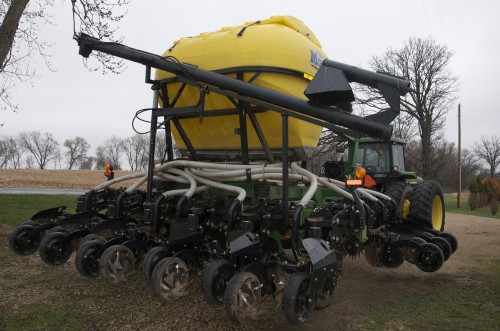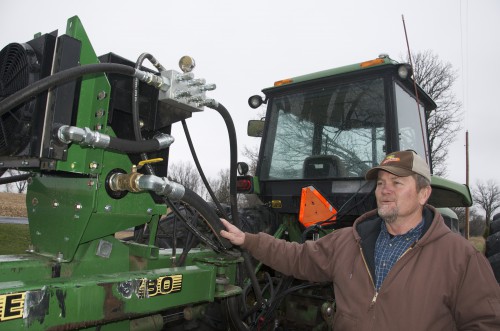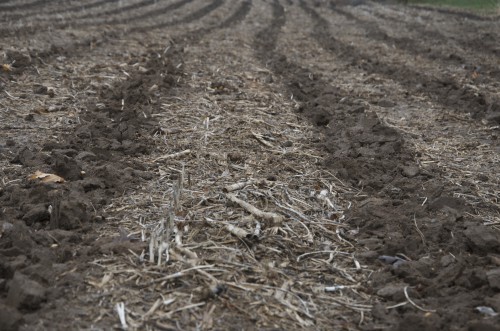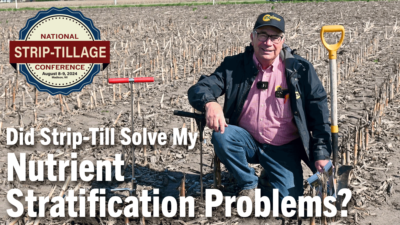With more than 40 years of conservation tillage practices under his belt, Alan Sweeney understands that reaching the goal of improving soil health and attaining higher yields doesn’t happen overnight.
After 30 years of no-tilling corn and soybeans, Sweeney moved to spring strip-till for corn after soybeans about a decade ago to create a better seedbed on his primarily heavy clay soils.
“We tried various attachments on corn planters and ran row cleaners to manage that no-till residue,” says Sweeney, who farms about 1,000 acres near Edgerton, Wis. “That didn’t work, so we knew we had to break that soil surface a little bit to get it dried out for the planter, and strip-till was a good solution.”
Tilling an 8-inch-wide strip with a homemade rig featuring Dawn Pluribus coulter-style row units, Sweeney has been able to improve seed-to-soil contact, which has led to better emergence, improved corn stands and about a 30-bushel-per-acre yield increase over 100% no-till.
But Sweeney admits his strip-till success isn’t a result of one factor. Building a strip-till rig to suit his field conditions and soil types, along with experimentation with fertilizer placement, have contributed to efficiency and profitability.
“My intent with strip-till was always to put some fertility down with that pass and not just have it be a land-preparation pass,” he says. “The ability to feed the crop is our best advantage with strip-till and I wanted a machine that could meet my expectations to do that.”
Equipment Evolution
Sweeney’s first strip-till rig was an anhydrous applicator he converted into a 12-row mole-knife unit. But rocky field conditions kept breaking shear bolts and he struggled to pull the unit with his older John Deere 4755 tractor.
|
|
He moved to a coulter-based machine several years ago, and this past winter built a new 12-row, 30-foot rig with second-generation Dawn Pluribus row units attached to an older John Deere 1780 planter bar.
“I felt comfortable with a coulter-type system, and the newer-generation row units are a little tougher because they have ¾-inch bolts in the coulters instead of the 5/8-inch width of the older units,” Sweeney says. “That lets me go as fast as 6½ mph — and with my high-output fertilizer-delivery system, I don’t have to worry about maxing out my application capacities.”
Sweeney mounted a Montag dry fertilizer bin on the bar, rather than use a fertilizer cart, because it makes the unit more compact and easier to navigate through some of his smaller fields.
While his 2-wheel-drive Deere 4755 tractor is able to pull the strip-till unit just fine, Sweeney had to enhance the hydraulic flow to run the fertilizer delivery system through his Raven 660 rate controller. He installed a Command Hydraulics HydraBoost system on the tractor hitch to provide enough hydraulic capacity to blend fertilizer into the strips.
“With an older tractor, I knew I needed to increase that flow, but I didn’t want to spend a couple hundred-thousand dollars on a new tractor and only use it 200 hours a year,” Sweeney says. “Right now, we can program two different application rates and we’ll be moving toward variable-rate fertilization in the future.”
Weighted Decision
When researching which bar to best carry the 500-pound row units, Sweeney chose the 1780 because he knew it could support the load. It’s designed to hold lighter planter units on 15-inch centers carrying 3-bushel seed boxes and two liquid fertilizer tanks.
|
|
“I wasn’t concerned with the overall weight, but I was concerned with the negative tongue weight, since the Pluribus units are heavier than the planter units,” Sweeney says. “I’m less than 2,000 pounds heavier, fully loaded. But one thing I had to do was flange out the two hinge points about 6 inches where the bar folds to get the row units bolted on.
“Otherwise, I might have had an issue carrying those outside rows because the strip-till units are wider than the planter units.”
In the future, Sweeney wants to convert his strip-till unit to tracks to provide more support and reduce field compaction.
Another modification he made was attaching a fertilizer auger on the back of the strip-till unit to allow for faster in-field loading of the Montag Mfg. fertilizer bin.
“We currently use a tender truck with an auger on it, but this setup offers us some flexibility if we want to use a gravity box to fill up,” he says. “As I get older, I didn’t want to fight with fertilizer augers anymore, so we decided to build this onto our unit.”
Fertilizing For Need
With a mix of heavy clay and sandy clay soils, Sweeney’s goal with fertilizer placement in strip-till is to be more precise with a banded application, rather than a broadcast approach with no-till.
|
|
In spring, he typically applies 100 pounds per acre of potash, 150 pounds of diammonium phosphate (DAP) and 100 pounds per acre of ammonium sulfate in the strip, along with about 12 pounds per acre of boron.
Sweeney then applies 12 to 18 gallons per acre of 28% nitrogen in 3-inch-by-2-inch placement with his 12-row John Deere 1770 planter.
He’s also experimented with applying a pop-up fertilizer with the planter. This is a nitrogen-potash-phosphorus (9-18-9) mix with zinc and a small amount of Capture LFR insecticide.
“The availability of nutrients across the board — whether it’s on our high-testing or low-testing soils in that strip — is the key to consistent, and even drought-resistant crops,” Sweeney says. “We treat fields differently, but we’ve been able to save 10% to 15% in fertilizer costs through more targeted applications based on soil tests, and my own intuition.”
Over the years, Sweeney’s soil structure has continuously improved, but he battles with high-magnesium and low-calcium soils that tend to make it tougher to maintain consistent crops. Another challenge is managing various pH levels and organic-matter levels.
On one of Sweeney’s rented fields, pH levels range from 5.7 to 6.0, with organic-matter levels averaging 2.7 and a low base-saturation rate of calcium and high rate of magnesium.
“This makes those soils very tight, so what we’re trying this year is an application of pelletized lime in the strip,” Sweeney says. “Our goal is to manage the crop, instead of managing the soil, by using a lime application in the strip to get those ratios in balance and boost the pH level to that 6.5 to 6.8 range.”
Sweeney is applying upwards of 50 pounds per acre of pelletized lime with the strip-till rig and will compare results with neighboring fields with similarly low pH levels in the fall that didn’t receive the application.
Sweeney admits that his tight clay soils don’t have the nutrient-holding capacity to achieve a substantial increase in organic-matter content. But he also doesn’t want to over-apply fertilizer and waster money if it’s not going to improve yield.
“We’d go bankrupt trying to build those soil levels up and it doesn’t make any sense because with that organic matter, it’s not going to hold those nutrients anyway,” he says. “Once we get to a point where we have fertility levels, pH, calcium and magnesium ratios in a balance, we may look at feeding the crop over and above the yield expectations we have now.”










Post a comment
Report Abusive Comment